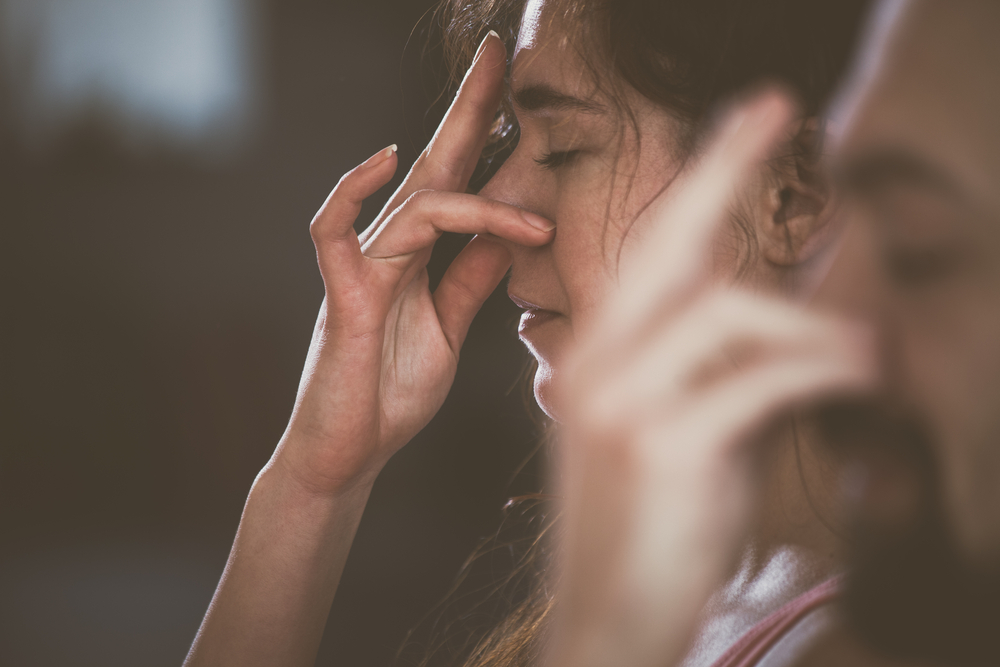Breathwork is often seen as a method to alleviate distress in yoga and meditation. However, less attention has been paid to studying breathwork as a non-drug intervention for anxiety treatment.
According to the new scoping review of breathwork published in Brain Sciences, existing studies suggest that varying breathwork interventions may help treat anxiety-related disorders.
The researchers, led by Dr. Blerida Banushi, highlight the importance of breathwork as an accessible and potentially effective intervention that can alleviate some of the increasing demands on existing mental health services.
“Despite their prevalence and disease burden, anxiety disorders remain under-diagnosed and under-treated,” the authors write. “Although pharmacological and psychotherapeutic options are available, many patients do not seek treatment and often face practical limitations, such as service cost, undesirable side effects, or lack of access to providers, and prefer to self-manage their condition instead … Hence, there is a need for cost-effective, non-pharmacologic, and self-administered therapies that can be utilized by large populations to relieve stress and anxiety.”
 Banushi and her team conducted a scoping review for breathwork interventions as anxiety treatment. The aim was to understand the broad picture of existing research on breathwork for anxiety. To do so, Banushi and her team followed the standard methodologies and guidelines for scoping reviews (PRSIMA-ScR and JBI) for overviewing multiple research studies.
Banushi and her team conducted a scoping review for breathwork interventions as anxiety treatment. The aim was to understand the broad picture of existing research on breathwork for anxiety. To do so, Banushi and her team followed the standard methodologies and guidelines for scoping reviews (PRSIMA-ScR and JBI) for overviewing multiple research studies.
Initially, 1,081 published studies were identified by searching key terms related to breathwork and anxiety disorder patients on popular research databases (PubMed, Embase, and Scopus). After removing studies that were duplicates or did not meet inclusion criteria, a few more studies were added from the cited sources of the initial studies.
After selection, 16 studies remained. Per inclusion criteria, assessed studies were all in English, involved adult patients with DSM-V-diagnosed anxiety-related disorder, and conducted clinical trials involving breathwork intervention/techniques. Within these studies, there was significant variation in publication year (1984-2022), mean age of the population (31.1-45.7), type of disorders (panic disorder, agoraphobia, generalized anxiety disorder, etc.), sample size (4-92), breathwork styles and frequency used for intervention (deep breathing, hyperventilation, etc.), and study design settings (randomized, clinical, research, or real world).
There were three main findings from the collective review of these studies.
“We conclude that breathwork interventions […] widely used to reduce stress among the general population are effective in targeting panic and stress in patients clinically diagnosed with anxiety. However, our analysis also suggests that breathwork techniques and protocols play significant roles in health outcomes.”
First, despite the diversity of protocol and breathwork type, most breathwork interventions from this scoping review showed significant anxiety improvement among patients with anxiety-related disorders. In particular, the efficacy of slow, diaphragmatic breathing and heart rate variability biofeedback (a mind-body technique where individuals manipulated physiological activity such as heart rate) had strong support across multiple studies.
Second, the difference in breathwork type and protocol significantly impacts health outcomes. For example, one of the only two studies that showed non-significant improvement for patients incorporated slow and shallow breath interventions. Yet, the same study showed significant improvement in physiological relaxation measures when the intervention was mixed with attention to the breath.
Third, there are mixed findings regarding the efficacies of breathwork involving deliberate hyperventilation in patients with panic disorder. According to Banushi, two conflicting theories were both supported by the studies of the reviews. Ley’s Hyperventilation theory suggests hyperventilation causes panic attacks, whereas Klein’s false-suffocation theory indicates that it is merely an over-sensitive, adaptive, compensatory behavior of the body to lower CO2 levels.
Banushi and her team speak to the complexity of this debate, and they suggest another potential role of hyperventilation:
“Breathing retraining for [panic disorder] PD is supported by both theories, with opposite respiratory goals. If the hyperventilation theory is true, breathwork should aim to prevent hyperventilation and subsequent panic attacks. If the false-suffocation alarm theory is true, then lowering pCO2—below the threshold for triggering the suffocation alarm—should be used instead.”
Further, Banushi proposes a third theory where hyperventilation plays a role in putting the practicer in an altered conscious state:
“Holotropic breathwork,[…] which combines faster and deeper breathing to induce intense altered states of consciousness, has been shown to increase self-awareness [and] could be useful in the treatment of anxiety and depressive disorders […] we hypothesize that the beneficial mechanisms of hyperventilation in breathing retraining, examined here, are common to holotropic breathwork and other techniques that invoke non-ordinary states of consciousness.”
Overall, this scoping review is limited by the variation in breathwork interventions among assessed studies. With each study incorporating different breathwork techniques with various protocols, patient populations, and outcome measures, it is particularly challenging to identify which intervention is most efficacious for specific populations.
Nevertheless, the study supports the clinical use of breathwork interventions as a treatment option for anxiety-related disorders. Banushi urges future research to explore optimization and standardization amongst breathwork interventions to be appropriately utilized in various clinical settings.
****
Banushi, B., Brendle, M., Raghildsteveit, A., Murphy, T., Moore, C., Egberts, J., Robinson, R. (2023). Breathwork INterventions for Adults with Clinically Diagnosed Anxiety Disorders: A Scoping Review. Brain Sciences. 13(256). 10.3390/brainsci13020256(Link)














